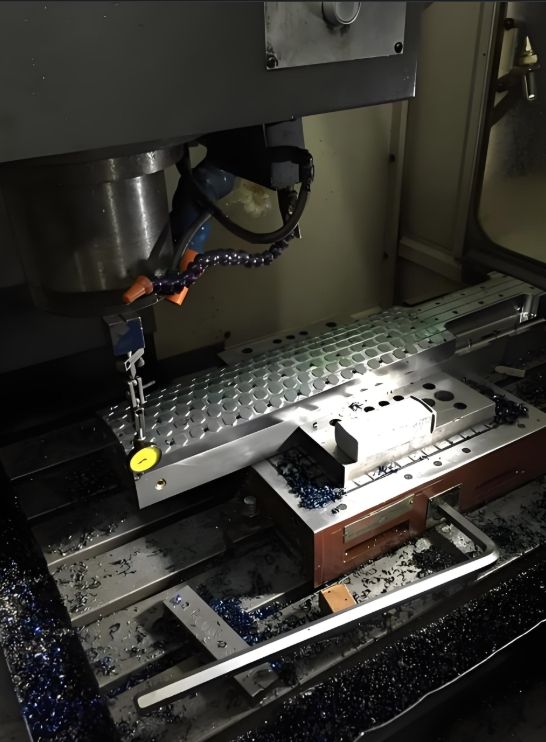The Invisible Pillar Behind Precision: The Key Dance of CNC and Large Server Heat Sink Connectors
Beneath the roar of data centers, vast computing power operates continuously, with its core lifeline relying on heat dissipation—a seemingly basic yet crucial element. Among many heat dissipation components, large server heat sink connectors play an indispensable pivotal role. Their efficiency largely depends on a manufacturing process that has been refined over time: CNC (Computer Numerical Control) machining technology.
When heat dissipation demands escalate to the kilowatt level and heat sinks become increasingly large and heavy, the role of connectors transcends simple pipe splicing. They bear the triple mission of stable heat transfer under extreme heat flux density, structural support under significant equipment loads, and precise alignment under stringent tolerance requirements. Traditional casting or ordinary cutting processes often fall short when facing millimeter or even micrometer-level fit precision, complex internal flow path surfaces, and the machining of high-strength materials (such as copper alloys and specific aluminum alloys).
Only CNC technology can respond perfectly to the stringent requirements of large heat sink connectors with the precision "touch" of metal cutting. Its core advantages include:
-
Accurate Reproduction of Complex Geometric Forms: Driven by digital programs, CNC machines can precisely carve out the internal winding coolant flow paths, critical sealing surfaces, precision mounting holes, and irregular structural contours of connectors from high-quality metal blanks. These precisely formed bends and curves, like a direct mapping of the design blueprint onto metal, create the least resistance pathways for coolant, allowing heat to silently and evenly dissipate from the core areas.
-
Empowering Material Limits: When faced with high thermal conductivity copper or tough high-strength aluminum alloys, modern CNC processes, with their high-speed spindles, extraordinary machine rigidity, and refined cutting tools, demonstrate powerful "taming" capabilities. They not only impart a mirror-like smoothness to the workpiece surface but also maintain the regularity and strength of the material's microcrystalline structure at a deeper level. This not only greatly smooths the turbulent heat waves of the coolant, effectively avoiding local high-temperature risks, but also enables large server heat sink connectors to exhibit extraordinary durability under the relentless thermal cycling tests of around-the-clock operation, providing enduring and reliable operation for the core cooling links of data centers.
-
Rigidity Barriers and Micron Precision: Modern high-performance CNC machining centers possess exceptional structural rigidity. Combined with thermal compensation algorithms and real-time monitoring feedback, they can maintain dimensional tolerances at the micron level even when machining large workpieces. This geometric fidelity at the micron scale plays a decisive role in maintaining the seamless sealing alliance and rock-solid mechanical connection between large server heat sink connector arrays, heat sink modules, cold plates, and fluid manifolds. Imagine in a densely packed cooling matrix, even a hair-thin geometric distortion or stress distortion at a connector interface could quietly tear an invisible crack, becoming a hidden channel for coolant escape or a sudden barrier on the heat conduction path. The rigidity and precision at the microscopic scale endowed by advanced CNC processes are the cornerstones for guarding against such risks and ensuring the long-term efficient coordinated operation of the vast cooling system.
At this moment, the heat waves from chips within the data center continue to surge, constantly pushing the frontier of heat dissipation. Connector designs are becoming increasingly precise and complex—integrated flow sensor interfaces, optimized turbulent disturbance microstructures, and irregular architectures optimized for specific topologies are emerging. These innovative designs are brought to life with the support of flexible and intelligent advanced CNC manufacturing platforms. The design and manufacturing stages are deeply coupled in the digital world, and through CNC, complex fluid simulations and topological optimization results are precisely replicated onto metal entities, continuously pushing the performance boundaries of large server heat sink connectors.
When we look through the layers of server cabinet structures, the large server heat sink connectors meticulously crafted by CNC technology are like invisible yet strong joints. They silently maintain the efficient operation of the vast cooling system, ensuring stable output of powerful computing power. In the pursuit of stronger computing power, the deep collaboration between precision CNC machining and core cooling components has become an indispensable cornerstone for building a reliable digital foundation.

